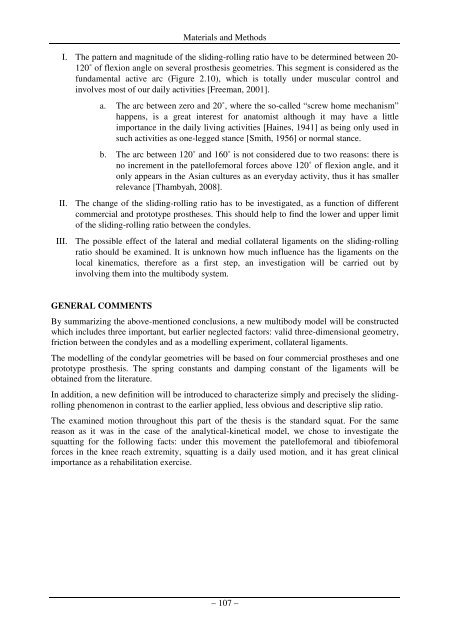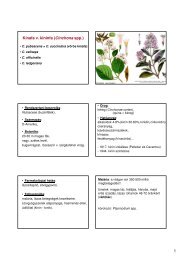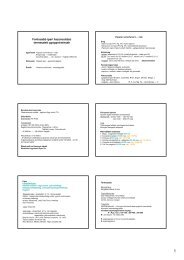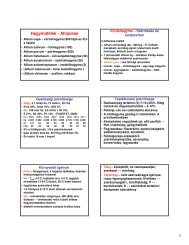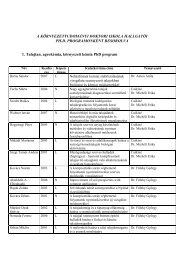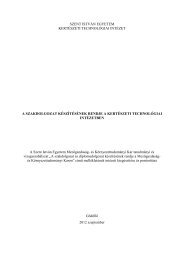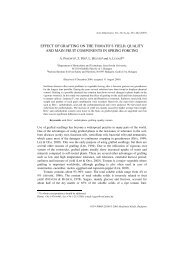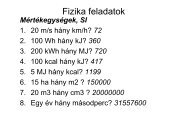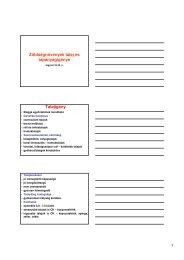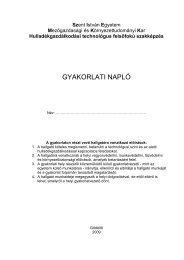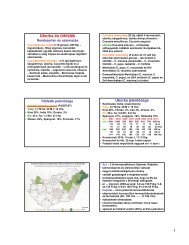PhD Fekete - SZIE version - 2.2 - Szent István Egyetem
PhD Fekete - SZIE version - 2.2 - Szent István Egyetem
PhD Fekete - SZIE version - 2.2 - Szent István Egyetem
Create successful ePaper yourself
Turn your PDF publications into a flip-book with our unique Google optimized e-Paper software.
Materials and Methods<br />
I. The pattern and magnitude of the sliding-rolling ratio have to be determined between 20-<br />
120˚ of flexion angle on several prosthesis geometries. This segment is considered as the<br />
fundamental active arc (Figure 2.10), which is totally under muscular control and<br />
involves most of our daily activities [Freeman, 2001].<br />
a. The arc between zero and 20˚, where the so-called “screw home mechanism”<br />
happens, is a great interest for anatomist although it may have a little<br />
importance in the daily living activities [Haines, 1941] as being only used in<br />
such activities as one-legged stance [Smith, 1956] or normal stance.<br />
b. The arc between 120˚ and 160˚ is not considered due to two reasons: there is<br />
no increment in the patellofemoral forces above 120˚ of flexion angle, and it<br />
only appears in the Asian cultures as an everyday activity, thus it has smaller<br />
relevance [Thambyah, 2008].<br />
II. The change of the sliding-rolling ratio has to be investigated, as a function of different<br />
commercial and prototype prostheses. This should help to find the lower and upper limit<br />
of the sliding-rolling ratio between the condyles.<br />
III. The possible effect of the lateral and medial collateral ligaments on the sliding-rolling<br />
ratio should be examined. It is unknown how much influence has the ligaments on the<br />
local kinematics, therefore as a first step, an investigation will be carried out by<br />
involving them into the multibody system.<br />
GENERAL COMMENTS<br />
By summarizing the above-mentioned conclusions, a new multibody model will be constructed<br />
which includes three important, but earlier neglected factors: valid three-dimensional geometry,<br />
friction between the condyles and as a modelling experiment, collateral ligaments.<br />
The modelling of the condylar geometries will be based on four commercial prostheses and one<br />
prototype prosthesis. The spring constants and damping constant of the ligaments will be<br />
obtained from the literature.<br />
In addition, a new definition will be introduced to characterize simply and precisely the slidingrolling<br />
phenomenon in contrast to the earlier applied, less obvious and descriptive slip ratio.<br />
The examined motion throughout this part of the thesis is the standard squat. For the same<br />
reason as it was in the case of the analytical-kinetical model, we chose to investigate the<br />
squatting for the following facts: under this movement the patellofemoral and tibiofemoral<br />
forces in the knee reach extremity, squatting is a daily used motion, and it has great clinical<br />
importance as a rehabilitation exercise.<br />
– 107 –


